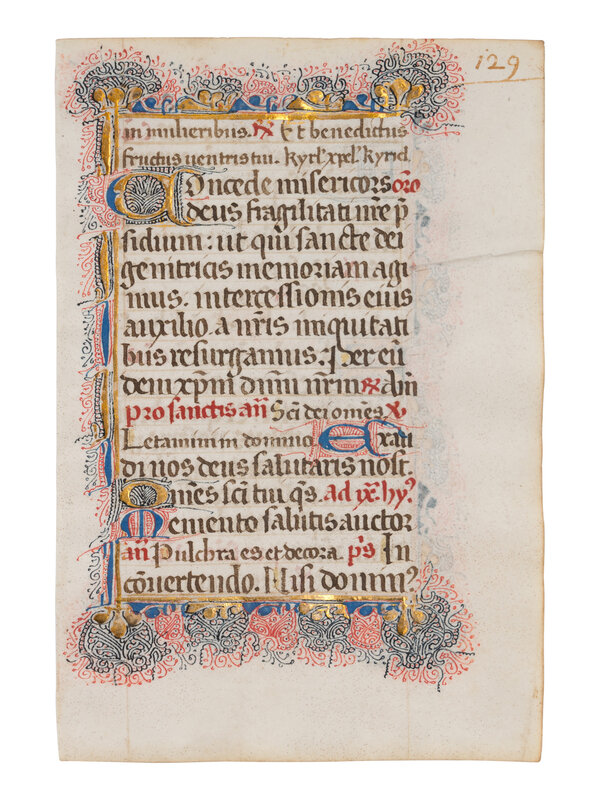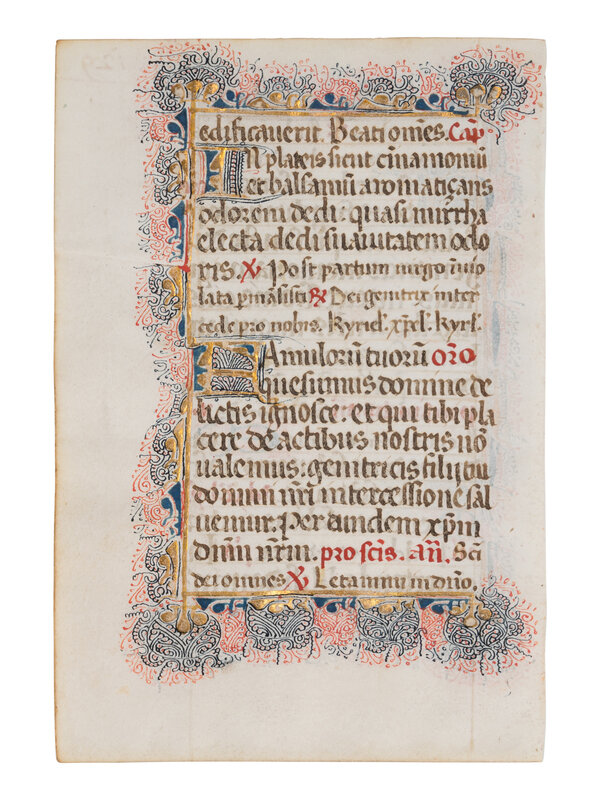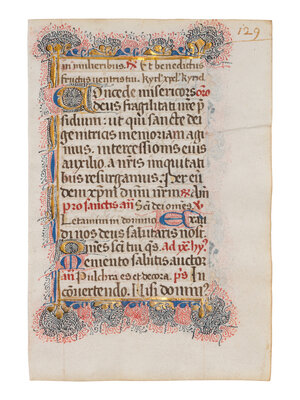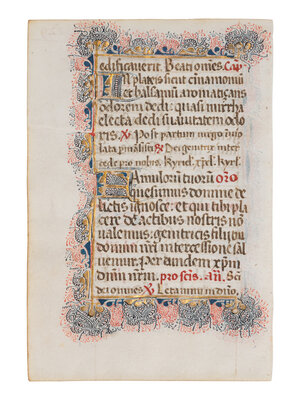Condition Report
Contact Information
Lot 35
ANONYMOUS SOUTHERN FRENCH ILLUMINATOR
A leaf from the “Cochon Hours,” in Latin, illuminated manuscript on parchment [France, Avignon, c. 1460-1470]
A leaf from the “Cochon Hours,” in Latin, illuminated manuscript on parchment [France, Avignon, c. 1460-1470]
Sale 2033 - Western Manuscripts and Miniatures
Jun 27, 2024
10:00AM CT
Live / Chicago
Own a similar item?
Estimate
$500 -
800
Price Realized
$254
Sold prices are inclusive of Buyer’s Premium
Lot Description
ANONYMOUS SOUTHERN FRENCH ILLUMINATOR
A leaf from the “Cochon Hours,” in Latin, illuminated manuscript on parchment [France, Avignon, c. 1460-1470]
A leaf from the “Cochon Hours,” in Latin, illuminated manuscript on parchment [France, Avignon, c. 1460-1470]
Remarkable leaf from a Book of Hours once belonging to Count Paul Durrieu with unusual decoration from Southeastern France, likely Avignon.
150 x 100 mm. Single leaf, ruled in brown ink for one column of 17 lines (written space: 100 x 60 mm), foliated “129” in brown ink in the upper right corner, written in brown ink in a rounded bastarda hand, rubrics in red, capitals touched with yellow, one-line initials alternating burnished gold on black penwork and blue on red and black penwork, two-line initials in burnished gold on blue ground and black penwork, accompanied with three-sided gold-bar border with half fleur-de-lis corners, alternating half fleur-de-lis in gold on black and red penwork or in blue on red and black penwork (some faints in the gold, browning on the edges, else in excellent condition).
This remarkable leaf comes from a dismantled Book of Hours for the use of Rome that was once part of the collection of Count Paul Durrieu (1855-1925), one of the first and foremost historians of late medieval French illumination, Curator at the Musée du Louvre in Paris. The parent manuscript offered an unusual textual content, as it opened with the Hours of the Cross, and included texts as rare as the Hours of Mary Magdalene, whose cult was centered in Southeastern France, the Joys of St. John the Evangelist, and the Psalter of the Virgin. The present leaf, foliated 129, belonged to the Hour of None of the Hours of the Virgin (ff. 121v-139v). That the Hours of the Virgin were preceded by the Hours of All Saints would account, in the present leaf, for the inclusion of specific rubrics for the saints. The rounded bastarda further suggests that the manuscript was written, decorated, and illuminated in Southeastern France, likely in Avignon.
Durrieu had already surmised that the manuscript was illuminated in Southeastern France. This is supported by the miniatures, which are based on models related to Pierre Villate (active in Avignon), and by the later addition of a full-page diptych emulating the Hours of René of Anjou due to Barthélemy d’Eyck (Paris, BnF, MS lat. 17332), as published by M.-Cl. Léonelli in 2009. This location accounts for the unusually rich decoration of the present leaf, that was shared by most text pages of the manuscript. It combines burnished gold initials and bar-borders with a dense black and red penwork decoration and half fleur-de-lis motifs. Both the copy and illumination are due to the hand responsible for a Miscellany dated 1469 (Lyon, Bibliothèque municipale, MS 624; see P. Kidd, 2019). Such decoration is also found in a later Book of Hours written for a knight of the Order of St. John of Jerusalem at the abbey St. Peter of Lagny-sur-Marne, historiated in Paris in the 1480s (Liege, University Library, MS Wittert 30).
Provenance
(1) Charles Edwin Puckett, his IM-3310, acquired by:
(2) Private collection, California, USA, MS 136.
Parent manuscript
1. The parent manuscript included 206 folios with ten full-page, two half-page, and one small miniatures. Stylistic evidence indicates that it was illuminated in Avignon, Southeastern France, c. 1460-1470.
2. Sixteenth-century notes regarding the Cochon family, documented in Rennes and Reims, appeared on the front pastedown, alongside further additions from the same family dated between 1593 and 1630.
3. Leo S. Olchski, Florence, published by him in 1910; acquired from him by:
4. Count Paul Durrieu (1855-1925).
5. The parent manuscript was last sold as complete by Sam Fogg (Catalogue 14, 1991, no 20) and Les Enluminures (Catalogue 6, 1997, no 13), and dismantled afterwards by its private owner.
Sister leaves
Four leaves with full-page miniatures depicting Christ as the Salvator Mundi and the Virgin Mary as a diptych, St. Anthony, and St. John on Patmos, were sold by Les Enluminures (Catalogue 15, 2010, no 26-28). Charles Edwin Puckett sold three further leaves with a full-page miniature of Job on the Dungheap (IM-12102), and half-page miniatures of the Adoration of the Magi and Last Supper (IM-2870, IM-12782). Finally, five further text leaves were sold by Phillip J. Pirages (Catalogue 44, no 588; Catalogue 70, no 300), and Charles Edwin Puckett (IM-13112).
LITERATURE
On the parent manuscript: Leo S. Olschki, Manuscrits sur vélin avec miniatures du Xe au XVIe siècle, Florence, 1910, no 38; Marie-Claude Léonelli, in Splendeur de l’enluminure. Le roi René et les livres, Angers, 2009, pp. 260-262; Peter Kidd, “A Manuscript in Lyon, Dated 1469,” Medieval Manuscripts Provenance, online, 2019.
Freeman’s | Hindman thank Senior Consultant Sandra Hindman and Elliott Adam for their assistance in preparing this sale.
Property of a Private California Collector



